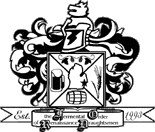 |
 |
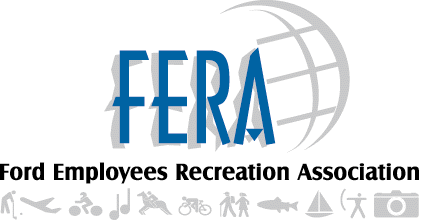 |
 |
 |
 |
| December 2003 | Fermental Order of Renaissance Draughtsmen | Volume 11 Number 12 |
The next meeting will be held back at Bailey's Pub 'N Grille in Dearborn on Tuesday, December 9. Bailey's is located on the southeast corner of Michigan and Mason. Their address is 22091 Michigan Avenue and their phone number is 313-277-3212. As usual, the thirsty hardcore who want dinner will start arriving around 5PM, people will drift in for an hour or so, and we will start our meeting around 6PM.
October's Belgian competition results are tabulated below.
| Belgian Competition | |||
|---|---|---|---|
| Place | Brewer | Style | Points |
| 1st | Chris Frey |
Belgian Tripel |
45/50 |
| 2nd | Chris Frey |
BFB |
41/50 |
| 3rd | Chris Cirino |
Saison |
40/50 |
| HM | Chris Frey |
Belgian Triple (Orval) |
39.5/50 |
| HM |
Chris Frey |
Belgian Dubbel |
33.5/50 |
| HM |
Mark Hansen |
Belgian Tripel |
32/50 |
| HM |
Chris Frey |
Belgian Dubbel |
31.5/50 |
| HM |
John and Sheila Rucinski |
Golden Ale |
30/50 |
| Wheat Beer Competition | |||
|---|---|---|---|
| Place | Brewer | Style | Points |
| 1st | Mike Arend and
Kathy Loftus |
Hefe Weizen |
43.7/50 |
| 2nd | Chris Cirino |
Hefe Weizen |
41/50 |
| 3rd | Steve Close |
American Wheat |
37/50 |
| HM | Bob and Kim
Barrett |
Autumn Wheat |
34.3/50 |
| Brown Ale Competition | |||
|---|---|---|---|
| Place | Brewer | Style | Points |
| 1st | Tony Tantillo |
Brown Porter |
40/50 |
| 2nd | Bob and Kim Barrett |
Robust Porter |
39.3/50 |
| 3rd | Mike Arend and Kathy Loftus |
Robust Porter |
38.7/50 |
| HM | John and Sheila Rucinski |
Oatmeal Stout |
38.3/50 |
| HM |
Don Beyer |
Brown Porter |
36/50 |
| HM |
Kathy Loftus |
Robust Porter |
34.3/50 |
Just a reminder, please don't tape the labels to the bottles. I have labels and rubber bands at every meeting. Also, please include your e-mail address on the label. This will help if there are any problems or questions about the entry.
This month's competition categories are Holiday Ales, English, Scottish Strong Ale, Barleywines and Imperial Stouts. This includes BJCP Category 12. Also please bring your entries for January 2004, Competition Category (AHA) - Barleywine - BJCP category 12. It is another AHA competition The details for the club only competition can be found on the appropriate AHA web page. Bottle and entry forms (useful for non-AHA competitions) can be found there too.The BJCP style guide for categories 11 and 12 are included below.
11. ENGLISH AND SCOTTISH STRONG ALE
11A. Old Ale
Aroma: Malty, with complex fruity esters. Some oxidative notes are acceptable, akin to those found in port or sherry. Hop aromas not usually present, due to extended age.
Appearance: Medium amber to very dark red-amber color.
Flavor: Malty and usually sweet, with abundant fruity esters. The nutty malt sweetness yields to a finish that may vary from dry to somewhat sweet. Extended aging may contribute oxidative flavors similar to a fine old port or Madiera wine. Alcoholic strength should be evident, though not overwhelming.
Mouthfeel: Medium to full body; alcohol should contribute some warmth.
Overall Impression: An ale of significant alcoholic strength, though usually not as strong or rich as barleywine. Usually tilted toward a sweeter, more malty balance.
History/Comments: Often regarded as winter warmers, and often released as seasonal beers.
Ingredients: Generous quantities of well-modified pale malt (generally English in origin, though not necessarily so), along with judicious quantities of caramel malts. Some darker examples suggest that dark malts may be appropriate, though sparingly so as to avoid roast character. Adjuncts (such as molasses or dark sugar) may also be utilized. Hop variety is not as important, as the relative balance and aging process negate much of the varietal character.
Vital Statistics: OG: 1.060-1.090+
IBUs: 30-60 FG: 1.015-1.022+
SRM: 12-16 ABV: 6-9+%
Commercial Examples: Theakston Old Peculier, Young's Winter Warmer, Marston Owd Roger.
11B. Strong Scotch Ale (Wee Heavy)
Aroma: Deeply malty, with caramel apparent. Roasty or even smoky secondary aromas may also be present, adding complexity. Moderate diacetyl character is also acceptable.
Appearance: Dark amber to dark brown color, often with ruby highlights.
Flavor: Intensely malty with kettle caramelization apparent. Hint of roasted malt or smoky flavor may be present, as may some buttery diacetyl or nutty character. Hop flavors are low, so malt impression should be dominant.
Mouthfeel: Full-bodied, with a thick, chewy viscosity. Alcoholic warmth should also be present.
Overall Impression: Rich and malty, reminiscent of a dessert. Complex secondary malt flavors prevent a one-dimensional impression.
History/Comments: Fermented at cooler temperatures than most ales, and with lower hopping rates, resulting in clean, intense malt flavors. Well suited to the region of origin, with abundant malt and cool fermentation and aging temperature. Hops, which are not native to Scotland and formerly expensive to import, were kept to a minimum.
Ingredients: Well-modified pale malt, with some crystal and perhaps a dash of darker malt or even roasted barley. A small proportion of smoked malt may add depth, though smoky character may also originate from the yeast. Hop presence is minimal, although English varieties are most authentic. Low-to-medium sulfate and medium carbonate/bicarbonate water is most appropriate.
Vital Statistics: OG: 1.072-1.088+
IBUs: 20-40 FG: 1.019-1.025+
SRM: 10-47 ABV: 6.9-8.5+
Commercial Examples: Traquair House, MacAndrew's Scotch Ale, McEwan's Scotch Ale, Belhaven Wee Heavy, Scotch du Silly, Vermont Pub and Brewery Wee Heavy.
BARLEYWINE AND IMPERIAL STOUT
12A. English-style Barleywine
Aroma: Moderate to intense fruitiness; presence of hops (English varieties) may range from mild to assertive. A caramel-like aroma is often present.
Appearance: Color may range from rich gold to very dark amber or even brown. Often has ruby highlights. May have low head retention.
Flavor: Fruity, with a great intensity of malt. Hop bitterness may range from just enough for balance to a firm presence; balance therefore ranges from malty to bitter. Some oxidative flavors may be present, and alcohol should be evident.
Mouthfeel: Full-bodied, with a slick, viscous texture. Gentle smooth warmth from alcohol should be present.
Overall Impression: The richest and strongest of the English Ales.
History/Comments: Usually the strongest ale offered by a brewery, and often vintage-dated. Normally aged significantly prior to release. Often associated with the winter or holiday season. Although a hoppy beer, the English Barleywine places less emphasis on hop character than the American Barleywine and features English hops.
Ingredients: Well-modified pale malt should form the backbone of the grist, with judicious amounts of caramel malts. Dark malts should be used with great restraint, if at all, as most of the color arises from a lengthy boil. English hops such as Northdown, Target, East Kent Goldings and Fuggles.
Vital Statistics: OG: 1.080-1.120+
IBUs: 50-100 FG: 1.020-1.030+
SRM: 10-22 ABV: 8-12+%
Commercial Examples: Anchor Old Foghorn, Young’s Old Nick, Fuller’s Golden Pride.
12B. American-Style Barleywine
Aroma: Moderate to intense fruitiness; presence of hops (typical American varieties) may range from moderate to dominant. A caramel-like aroma is often present.
Appearance: Color may range from rich gold to very dark amber or even brown. Often has ruby highlights. May have low head retention.
Flavor: Fruity, with a great intensity of malt. Hop bitterness may range from just enough for balance to a firm, resiny dominance; balance therefore ranges from slightly malty to intensely bitter. Some oxidative flavors maybe present, and alcohol should be evident.
Mouthfeel: Full-bodied, with a slick, viscous texture. Gentle smooth warmth from alcohol should be present.
Overall Impression: A well-hopped American interpretation of the richest and strongest of the English ales.
History/Comments: Usually the strongest ale offered by a brewery, and often vintage-dated. Normally aged significantly prior to release. Often associated with the winter or holiday season. The American version of the Barleywine tends to have a greater emphasis on hop bitterness, flavor and aroma than the English Barleywine, featuring American hop varieties.
Ingredients: Well-modified pale malt should form the backbone of the grist, with judicious amounts of caramel malts. Dark malts should be used with great restraint, if at all, as most of the color arises from a lengthy boil. American hops such as Cascades and Centennial.
Vital Statistics: OG: 1.080-1.120+
IBUs: 50-100 FG: 1.020-1.030+
SRM: 10-22 ABV: 8-12+%
Commercial Examples: Sierra Nevada Bigfoot, Rogue Old Crustacean, Victory Old Horizontal.
12C. Russian Imperial Stout
Aroma: Fruity esters, reminiscent of dark fruit, merged with intense roastiness and maltiness. Hop aroma is usually also present.
Appearance: Very dark reddish-black color; opaque.
Flavor: Intensely fruity and malty, backed up by balancing roastiness and prominent hop bitterness and flavor. A "burnt currant" character may be present, along with a suggestion of cocoa or strong coffee. Alcoholic strength should be evident, along with a deep, complex malt flavor. The finish can vary from relatively dry to moderately sweet, usually with some lingering roastiness and warming character.
Mouthfeel: Very full-bodied and rich, with intense flavors and perceptible alcohol presence. Carbonation is relatively low.
Overall Impression: An intensely flavorful beer. Roasty, fruity, and bittersweet, with a notable alcohol presence. Dark fruit melds with roasty, burnt, almost tar-like sensations.
History: Said to be popular with the Russian Imperial Court.
Comments: Brewed to high gravity and hopping level in England for export to the Baltic States and Russia.
Ingredients: Well-modified pale malt, with generous quantities of roasted grain. Flavor and aroma hops should include English varieties for authenticity. Alkaline water would balance the abundance of acidic roasted grain in the grist.
Vital Statistics: OG: 1.075-1.095+
IBUs: 50-90+ FG: 1.018-1.030+
SRM: 20-40 ABV: 8-12+%
Commercial Examples: Samuel Smith Imperial Stout, Courage Imperial Stout, Brooklyn Black Chocolate Stout, Rogue Imperial Stout, North Coast Old Rasputin Imperial Stout, Victory Storm King.
As promised last month, here is Al's narrative and pictures. -- Editor.
My wife and I recently had the pleasure
of visiting Toppenish Washington. We happened on the town
serendipitously while driving though central
Washington. Toppenish is just up the road from Yakima home
to the Washington wine industry. Among other things, Toppenish is
the headquarters
of the Yakama Indian Nation, whose reservation covers more than a
million acres. Also, Toppenish is known as the "City of
Murals". Artists are
transforming the outside walls of many buildings with colorful scenes
depicting pioneer and Native American life in the area.
Finally, and most
important to us, Toppenish is home to the American Hop Museum! We
spent an enjoyable hour browsing through the history of hop growing in
the Washington area. While there I learned that Washington is the
second largest hop producer in the world, second only to Germany.
After leaving the museum, we wandered around town viewing the murals
which were very impressive. The pictures of the Hop Museum show
some of the paintings. Note that the architectural details on the
museum have been painted on! We then drove into Yakima to see what
could be found. Wandering around downtown, I sniffed that
heavenly scent which blooms just after dumping a load of hops into
boiling wort! Is someone brewing close by? I told Cathy
that it must be another of those great Washington Micro's, and I was
thirsty! Following my nose, I found the Hollingberry and
Son hop warehouse. The bales shown being moved by fork lift are drying
hops. The inside of the warehouse was stacked floor to
ceiling! Hop Head Heaven! All in all it was a very enjoyable day
and anyone traveling to Seattle should take the drive out and visit!
 |
 |
 |
 |
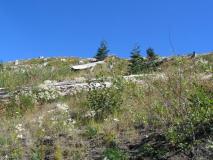 |
 |
 |
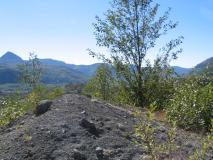 |
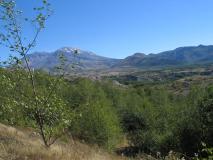 |
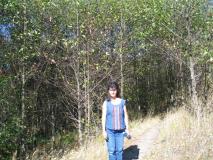 |
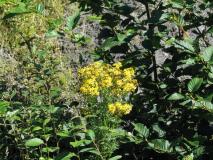 |
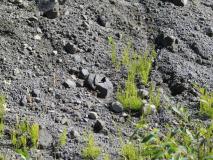 |
 |
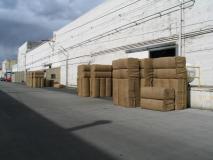 |
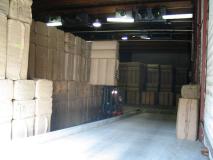 |
Next month's competition is Barley Wines, BJCP category 12. It
is an AHA club only competition. Because of the competition entry
date, please bring your entries to this month's meeting.
BARLEYWINE AND IMPERIAL STOUT
12A. English-style Barleywine
Aroma: Moderate to intense fruitiness; presence of hops (English varieties) may range from mild to assertive. A caramel-like aroma is often present.
Appearance: Color may range from rich gold to very dark amber or even brown. Often has ruby highlights. May have low head retention.
Flavor: Fruity, with a great intensity of malt. Hop bitterness may range from just enough for balance to a firm presence; balance therefore ranges from malty to bitter. Some oxidative flavors may be present, and alcohol should be evident.
Mouthfeel: Full-bodied, with a slick, viscous texture. Gentle smooth warmth from alcohol should be present.
Overall Impression: The richest and strongest of the English Ales.
History/Comments: Usually the strongest ale offered by a brewery, and often vintage-dated. Normally aged significantly prior to release. Often associated with the winter or holiday season. Although a hoppy beer, the English Barleywine places less emphasis on hop character than the American Barleywine and features English hops.
Ingredients: Well-modified pale malt should form the backbone of the grist, with judicious amounts of caramel malts. Dark malts should be used with great restraint, if at all, as most of the color arises from a lengthy boil. English hops such as Northdown, Target, East Kent Goldings and Fuggles.
Vital Statistics: OG: 1.080-1.120+
IBUs: 50-100 FG: 1.020-1.030+
SRM: 10-22 ABV: 8-12+%
Commercial Examples: Anchor Old Foghorn, Young’s Old Nick, Fuller’s Golden Pride.
12B. American-Style Barleywine
Aroma: Moderate to intense fruitiness; presence of hops (typical American varieties) may range from moderate to dominant. A caramel-like aroma is often present.
Appearance: Color may range from rich gold to very dark amber or even brown. Often has ruby highlights. May have low head retention.
Flavor: Fruity, with a great intensity of malt. Hop bitterness may range from just enough for balance to a firm, resiny dominance; balance therefore ranges from slightly malty to intensely bitter. Some oxidative flavors maybe present, and alcohol should be evident.
Mouthfeel: Full-bodied, with a slick, viscous texture. Gentle smooth warmth from alcohol should be present.
Overall Impression: A well-hopped American interpretation of the richest and strongest of the English ales.
History/Comments: Usually the strongest ale offered by a brewery, and often vintage-dated. Normally aged significantly prior to release. Often associated with the winter or holiday season. The American version of the Barleywine tends to have a greater emphasis on hop bitterness, flavor and aroma than the English Barleywine, featuring American hop varieties.
Ingredients: Well-modified pale malt should form the backbone of the grist, with judicious amounts of caramel malts. Dark malts should be used with great restraint, if at all, as most of the color arises from a lengthy boil. American hops such as Cascades and Centennial.
Vital Statistics: OG: 1.080-1.120+
IBUs: 50-100 FG: 1.020-1.030+
SRM: 10-22 ABV: 8-12+%
Commercial Examples: Sierra Nevada Bigfoot, Rogue Old Crustacean, Victory Old Horizontal.
12C. Russian Imperial Stout
Aroma: Fruity esters, reminiscent of dark fruit, merged with intense roastiness and maltiness. Hop aroma is usually also present.
Appearance: Very dark reddish-black color; opaque.
Flavor: Intensely fruity and malty, backed up by balancing roastiness and prominent hop bitterness and flavor. A "burnt currant" character may be present, along with a suggestion of cocoa or strong coffee. Alcoholic strength should be evident, along with a deep, complex malt flavor. The finish can vary from relatively dry to moderately sweet, usually with some lingering roastiness and warming character.
Mouthfeel: Very full-bodied and rich, with intense flavors and perceptible alcohol presence. Carbonation is relatively low.
Overall Impression: An intensely flavorful beer. Roasty, fruity, and bittersweet, with a notable alcohol presence. Dark fruit melds with roasty, burnt, almost tar-like sensations.
History: Said to be popular with the Russian Imperial Court.
Comments: Brewed to high gravity and hopping level in England for export to the Baltic States and Russia.
Ingredients: Well-modified pale malt, with generous quantities of roasted grain. Flavor and aroma hops should include English varieties for authenticity. Alkaline water would balance the abundance of acidic roasted grain in the grist.
Vital Statistics: OG: 1.075-1.095+
IBUs: 50-90+ FG: 1.018-1.030+
SRM: 20-40 ABV: 8-12+%
Commercial Examples: Samuel Smith Imperial Stout, Courage Imperial Stout, Brooklyn Black Chocolate Stout, Rogue Imperial Stout, North Coast Old Rasputin Imperial Stout, Victory Storm King.
Rich Byrnes' notes from the prez
column from December 1998 is presented here.
Well, I said last month was my last notes from the prez... I lied, so impeach me. I can't tell you how proud I am of this club, a pet project that began 5 years ago. This may be old news for some of you, but I'm guessing many of you may have no idea how the club was started.
Back in the summer of '93 Mike Preston and myself were both members of the Detroit Carboys, a great homebrewing club on the East side, we had a lot of fun in the carboys, it was a small club (less than a dozen members) and we met at members homes every month. Mike and I realized that there was no club to serve the Detroit/Dearborn area and we set down to creating this club.
Our biggest stumbling block was a meeting location, but Mark Tenbrink talked to the owners of Traffic Jam & Snug, Michigans first brewpub and we had our first meeting in August of '93. About 18 people showed up and almost all of them paid dues that night, and I believe all but 2 of those are still members. We stayed at Traffic Jams for a couple years until we outgrew it and found a home in Dearborn... Chelsea's.
Our club had quickly grown from about 25 people in our first year to over 100 in 3 years. Our club was quickly recognized for it's quality of members and asked to be the club to work the Rivertown Beer fest, until they needed 100 volunteers and we asked other clubs for help. Our club has always had excellent rapport with the homebrewing retailers, we have done at least 2 or 3 demos a year for the retailers, showing how beer is made for the public (one year we did 3 different locations in one day).
Several people are responsible for the club's success. I credit every person who has volunteered for an officer position, especially Sandy Bruce who was our treasurer for 4 years, Neal Petty (president for 2 years), Chris Frey, Ted Geftos, Johanne Wilson, Mike Preston, Doug Geiss, Tom Herron, Tim Tepatti, Tony Treusch, Jim Racine, Mike Arend, Pat Babcock, and David Peters. This club has grown, we are more than the sum of the members, we are a community. It's true that as a club we only see each other once a month, but several new friendships have formed and people brew together, several husbands and wives are members together, I love seeing that kind of support and friendship over a hobby like this. We are a community of young kids with eager eyes, soaking up the advice of the grizzled elders of the club, sitting on the porch telling tales of what it was like brewing when they were kids, sharing a few secrets and recipes as they spin their tales. We are a family, all helping each other when needed, offering our help for the funky brews, and congratulations on the award winning ones.
My point is this (you knew there was eventually a point, right?) I look out at the club as I turn the reins over to Pat Babcock with full confidence in both his goals and ideals as the president (and friend) and in you as a club that we will continue to grow and prosper. Thank you for all your support for the last 2 years while I was president, and over the lifetime of the club as we all grew up together. Welcome to all the new members and new brewers to our family, hang on tight and enjoy the ride, I know I have!
| Beer Events, Meetings & Competitions |  |
| Ye Olde Brew
News published by the F.O.R.D. Homebrew Club |
|
| Editor: Tony Tantillo Contributors: Club Officers: |
F.O.R.D. is a private, non-profit organization
of homebrewers. The main goal of this club is to promote awareness and
appreciation of
the quality and variety of beer; to share information regarding
technique,
equipment and skill required to brew quality homemade beer; and to
encourage
responsible use of beer as an alcohol-containing beverage. Howard Klix Jr. 24737 Cushing Ave Eastpointe, MI 48021 Phone: (586) 779-1445 Visit our website at: http://www.be.ford.com/brewers/
current circulation... 125 |